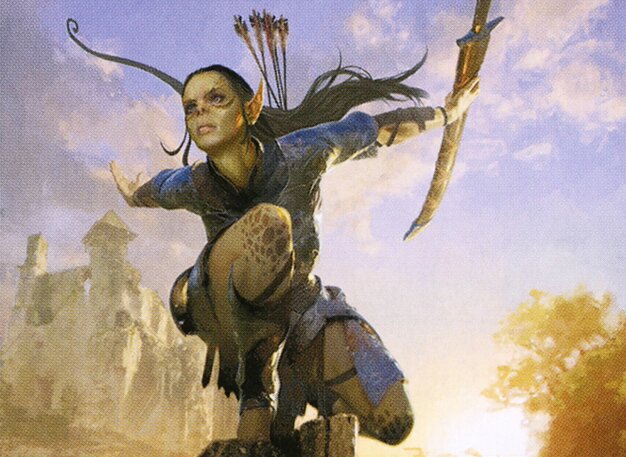 Art by John Stanko
Art by John StankoThis cube contains two of each common and one of each uncommon, rare, and mythic from the CLB set.
The cube should be drafted in 20-card packs, with 3-4 packs per person in a 4 person draft or 3 packs per person in an 6-10 person draft. However, 3 or 5 person games should probably be avoided given the myriad mechanic present in the set. The mechanic becomes much less powerful at 3 players and much more powerful at 5.
This set is drafted as any normal set would be, except each player takes two cards rather than one before passing a pack. It is important to remember to draft a commander. You'll be building a 60-card deck that must adhere to commander color identity rules but does not have to be singleton.
Archetypes
 Blink Send your creatures across the entire city, exiling then returning them to the board to reuse their abilities when they enter the battlefield!
Blink Send your creatures across the entire city, exiling then returning them to the board to reuse their abilities when they enter the battlefield!

 Initiative Using a mix of roguish evasion and sturdy defense, take the initiative and delve deeper into the Undercity dungeon than anyone has before!
Initiative Using a mix of roguish evasion and sturdy defense, take the initiative and delve deeper into the Undercity dungeon than anyone has before!

 Treasure & Sacrifice All things, including people, are just tools in Baldur's Gate. Sacrifice creatures and artifacts to further your plans-and make some coin while you're at it!
Treasure & Sacrifice All things, including people, are just tools in Baldur's Gate. Sacrifice creatures and artifacts to further your plans-and make some coin while you're at it!

 Dragons: Power Using mighty dragonborn and even mightier dragons, overwhelm your opponents with a draconic beatdown!
Dragons: Power Using mighty dragonborn and even mightier dragons, overwhelm your opponents with a draconic beatdown!

 Tokens Never travel alone in the city. Create an abundant force of creature tokens to easily outnumber your foes!
Tokens Never travel alone in the city. Create an abundant force of creature tokens to easily outnumber your foes!

 Aristocrats Turn loss into profit as you benefit from your creatures and other permanents leaving the battlefield for any reason.
Aristocrats Turn loss into profit as you benefit from your creatures and other permanents leaving the battlefield for any reason.

 Dragons: Spells Using draconic spells, keep your opponents in check as you build up mana to unleash large dragons that threaten the skies!
Dragons: Spells Using draconic spells, keep your opponents in check as you build up mana to unleash large dragons that threaten the skies!

 Graveyard Fill the graveyard with fallen creatures-only to reap advantage from the death you have sown.
Graveyard Fill the graveyard with fallen creatures-only to reap advantage from the death you have sown.

 Myriad You excel at fighting many foes at once! Use creatures with myriad to attack each of your opponents and stay on the offensive.
Myriad You excel at fighting many foes at once! Use creatures with myriad to attack each of your opponents and stay on the offensive.

 Dragons: Ramp Giant dragons are the aim; ramp is the game! Bide your time until you can cast some of the most ancient dragons the realms have to offer!
Dragons: Ramp Giant dragons are the aim; ramp is the game! Bide your time until you can cast some of the most ancient dragons the realms have to offer!
Decks must be exactly 60 cards, including commander(s). In general a deck is split: 24-26 lands, 31-36 playables, 1-2 commanders.
Each deck must have a commander.
Color identity rules apply. You cannot play with any cards that have mana symbols on them not found on your commander(s).
The "singleton" rule normally used in Commander games does not apply. You can play as many copies of the same card as you draft.
If required, Faceless One can be used as either a commander or a background of any color.
Set ModificationsThe following modifications are made to the set to improve the cube experience:
- Faceless One is not included in packs, but instead is set aside and available to all players if required.
- The 5 rare dual lands and Reflecting Pool are removed and replaced with additional dual gates and the Heap Gate. The dual lands and pool are not exciting or all that useful in a cube. This should help enable gate strategies that proved nearly impossible in the original set.
To replicate the original draft experience as closely as is reasonable, I plan to build packs based primarily on rarity and using a shuffling method that makes it more likely for each pack to contain at least one card of every color. This shuffling method is adapated from the novel shuffling method originally posted on Reddit: https://www.reddit.com/r/mtgcube/comments/34fet8/novel_method_for_shuffling_a_cube/
ShufflingThe below method should result in a fair color distribution in each pack with a very high likelihood of each pack containing at least 1 card of each color:
- Create 3 piles of each of the 5 colors and for "everything else" colorless/mutlicolor/land. A pile containing the commons in the color, a pile of all uncommons, and a pile of all rares/mythics. There should be 18 piles total.
- Shuffle all piles individually.
- Follow the following steps for each of the 3 rarity groups: common, uncommon, and rare/mythic:
a. For each of the monocolored piles for the given rarity, move ~50% of the cards to the "everything else" pile.
b. Shuffle the "everything else" pile.
c. From the "everything else pile", distribute cards into each monocolored pile evenly.
d. This should result in 5 piles of the given rarity, each pile containing mostly a single color.
e. Shuffle each pile individually.
f. Set the piles aside for pack-building.
The piles from shuffling are used in pack-building to ensure a proper distribution of color/rarity.
- Create 20 piles of commons with 11 commons each, 2 from each common pile and one from a random common pile.
- Add 5 uncommons to each pile, 1 from each uncommon pile.
- Add 4 rares/mythics to each pile, excluding one source pile randomly.
- If desired, finish 5 more piles with the remaining cards using the distribution in the following table. Note that due to the cube being 501 cards, there will be 1 card remaining, preferably a common:
| Packs | commons | Uncommons | Rare/Mythic |
| --- | --- | --- | --- |
| 20 | 11 | 5 | 4 |
| 3 | 13 | 4 | 3 |
| 2 | 12 | 5 | 3 |
If only 24 packs are desired, the following split is simpler and more consistent but leaves out ~20 commons and 1 uncommon:
| Packs | commons | Uncommons | Rare/Mythic |
|---|---|---|---|
| 23 | 11 | 5 | 4 |
| 1 | 11 | 6 | 3 |
In the 501-card base cube there are:
284 commons (56.7%)
122 uncommons (24.3%)
95 rare/mythic (19%)
Evenly spread, this results in each pack containing:
11-12 commons
4-5 uncommons
3-4 rare/mythics
